Efficient Directional Antenna Design Suitable for Ubiquitous Power Internet of Things
Abstract
:1. Introduction
2. Backscatter Communication System for Power Internet of Things
3. Antenna Structure and MOGA Optimization
3.1. Receiving Antenna Structure
3.2. Transmitting Antenna Structure
3.3. MOGA Optimization
- Bandwidth:
- 2.
- Gain:
- 3.
- Side lobes:
4. Simulation and Test Results
4.1. Simulation Results of the Two Antennas
4.2. Anechoic Chamber Test
4.2.1. Receiving Antenna Performance Verification
4.2.2. Transmitting Antenna Performance Verification
4.2.3. Transceiver Module Performance Verification
5. Conclusions
Author Contributions
Funding
Conflicts of Interest
References
- Song, S.M.; Yao, W.J. Research on the Application Value of Wireless Mesh Network in Power Equipment of the UPIOT. J. Phys. Conf. Ser. 2019, 1346, 012046. [Google Scholar] [CrossRef] [Green Version]
- Wang, Q.; Zhao, D.; Yang, B.; Li, C. Risk assessment of the UPIoT construction in China using combined dynamic weighting method under IFGDM environment. Sustain. Cities Soc. 2020, 60, 102199. [Google Scholar] [CrossRef]
- Kang, C.H.; Lee, W.S.; You, Y.H.; Song, H.K. Signal detection scheme in ambient backscatter system with multiple antennas. IEEE Access 2017, 5, 14543–14547. [Google Scholar] [CrossRef]
- Gope, P.; Amin, R.; Islam, S.H.; Kumar, N.; Bhalla, V.K. Lightweight and privacy-preserving RFID authentication scheme for distributed IoT infrastructure with secure localization services for smart city environment. Future Gener. Comput. Syst. 2018, 83, 629–637. [Google Scholar] [CrossRef]
- Darsena, D. Noncoherent detection for ambient backscatter communications over OFDM signals. IEEE Access 2019, 7, 159415–159425. [Google Scholar] [CrossRef]
- Parks, A.N.; Liu, A.; Gollakota, S.; Smith, J.R. Turbocharging ambient backscatter communication. ACM SIGCOMM Comput. Commun. Rev. 2014, 44, 619–630. [Google Scholar] [CrossRef]
- Bharadia, D.; Joshi, K.R.; Kotaru, M.; Katti, S. Backfi: High throughput wifi backscatter. ACM SIGCOMM Comput. Commun. Rev. 2015, 45, 283–296. [Google Scholar] [CrossRef]
- El Mossallamy, M.; Han, Z.; Pan, M.; Jantti, R.; Seddik, K.; Li, G.Y. Noncoherent frequency shift keying for ambient backscatter over OFDM signals. In Proceedings of the ICC 2019–2019 IEEE International Conference on Communications (ICC), Shanghai, China, 20–24 May 2019; pp. 1–6. [Google Scholar]
- Xu, C.; Yang, L.; Zhang, P. Practical backscatter communication systems for battery-free Internet of Things: A tutorial and survey of recent research. IEEE Signal Process. Mag. 2018, 35, 16–27. [Google Scholar] [CrossRef]
- Guo, J.; Durrani, S.; Zhou, X. Monostatic backscatter system with multi-tag to reader communication. IEEE Trans. Veh. Technol. 2019, 68, 10320–10324. [Google Scholar] [CrossRef]
- Pereira, F.; Sampaio, H.; Chaves, R.; Correia, R.; Luís, M.; Sargento, S.; Jordão, M.; Almeida, L.; Senna, C.; Oliveira, A.S.R.; et al. When backscatter communication meets vehicular networks: Boosting crosswalk awareness. IEEE Access 2020, 8, 34507–34521. [Google Scholar] [CrossRef]
- Chen, C.; Wang, G.; Guan, H.; Liang, Y.C.; Tellambura, C. Transceiver design and signal detection in backscatter communication systems with multiple-antenna tags. IEEE Trans. Wirel. Commun. 2020, 19, 3273–3288. [Google Scholar] [CrossRef]
- Amato, F.; Occhiuzzi, C.; Marrocco, G. Epidermal backscattering antennas in the 5G framework: Performance and perspectives. IEEE J. Radio Freq. Identif. 2020, 4, 176–185. [Google Scholar] [CrossRef]
- Zhang, J.; Lv, L.; Zhu, M.; Zhang, Q. Research on Intelligent Substation Wireless Sensor Network System Architecture Based on Internet of Things Technology. In Proceedings of the 2020 Prognostics and Health Management Conference (PHM-Besançon), Besancon, France, 4–7 May 2020; pp. 324–327. [Google Scholar]
- Hussien, N.; Ajlan, I.; Firdhous, M.M.; Alrikabi, H. Smart Shopping System with RFID Technology Based on Internet of Things. iJIM 2020, 14, 17–29. [Google Scholar] [CrossRef]
- Min, X.; Kuang, W. Study on the ecological farming control system based on the Internet of Things. Wirel. Pers. Commun. 2018, 102, 2955–2967. [Google Scholar] [CrossRef]
- Sharif, A.; Li, J.P.; Saleem, M.A. Internet of things enabled vehicular and ad hoc networks for smart city traffic monitoring and controlling: A review. Int. J. Adv. Netw. Appl. 2018, 10, 3833–3842. [Google Scholar] [CrossRef]
- Chen, Q. Research on Implementation Strategy of Ubiquitous Power Internet of Things. Power Gener. Technol. 2019, 40, 99. [Google Scholar]
- Liu, Y.; Yang, C.; Jiang, L.; Xie, S.; Zhang, Y. Intelligent edge computing for IoT-based energy management in smart cities. IEEE Netw. 2019, 33, 111–117. [Google Scholar] [CrossRef]
- Liang, X.; Sun, D.; Li, W. Composition Form and Function Configuration of Intelligent Terminal Based on Edge Computing for Power Internet of Things. IOP Conf. Ser. Earth Environ. Sci. 2021, 621, 012058. [Google Scholar] [CrossRef]
- Amato, F.; Torun, H.M.; Durgin, G.D. RFID backscattering in long-range scenarios. IEEE Trans. Wirel. Commun. 2018, 17, 2718–2725. [Google Scholar] [CrossRef]
- Zhang, J.; Tian, G.Y.; Marindra, A.M.; Sunny, A.I.; Zhao, A.B. A review of passive RFID tag antenna-based sensors and systems for structural health monitoring applications. Sensors 2017, 17, 265. [Google Scholar] [CrossRef]
- Pawłowicz, B.; Salach, M.; Trybus, B. Smart city traffic monitoring system based on 5G cellular network, RFID and machine learning. In KKIO Software Engineering Conference; Springer: Cham, Switzerland, 2018; pp. 151–165. [Google Scholar]
- Khan, S.F. Health care monitoring system in Internet of Things (IoT) by using RFID. In Proceedings of the 2017 6th International Conference on Industrial Technology and Management (ICITM), Cambridge, UK, 7–10 March 2017; pp. 198–204. [Google Scholar]
- Casula, G.A.; Maxia, P.; Mazzarella, G.; Montisci, G. Design of a printed log-periodic dipole array for ultra-wideband applications. Prog. Electromagn. Res. 2013, 38, 15–26. [Google Scholar] [CrossRef] [Green Version]
- Shen, X.; Liu, Y.; Zhao, L.; Huang, G.L.; Shi, X.; Huang, Q. A miniaturized microstrip antenna array at 5G millimeter-wave band. IEEE Antennas Wirel. Propag. Lett. 2019, 18, 1671–1675. [Google Scholar] [CrossRef]
- Xu, Z.M.; Wu, Y.W.; Tao, M.C.; Hao, Z.C. A Frequency Reconfigurable Slot Antenna Backed by the Substrate Integrated Waveguide Cavity for 5G Applications. In Proceedings of the 2019 International Conference on Microwave and Millimeter Wave Technology (ICMMT), Guangzhou, China, 19–22 May 2019; pp. 1–3. [Google Scholar]
- Sun, Y.; Liu, Y.; Tang, N.; Xu, D.; Li, Y.; Yu, Y.; Zhang, K.; Gou, Q.; Du, Z. The design of end-fire antenna with log-period directors. In Proceedings of the 2018 International Workshop on Antenna Technology (iWAT), Nanjing, China, 5–7 March 2018; pp. 1–3. [Google Scholar]
- McLean, J. Topology for Maintaining Symmetry in Hybrid LPDA-Broadband-Dipole Antennas. In Proceedings of the 2019 Antenna Measurement Techniques Association Symposium (AMTA), San Diego, CA, USA, 6–11 October 2019; pp. 1–6. [Google Scholar]
- Chang, L.; He, S.; Zhang, J.Q.; Li, D. A compact dielectric-loaded log-periodic dipole array (LPDA) antenna. IEEE Antennas Wirel. Propag. Lett. 2017, 16, 2759–2762. [Google Scholar] [CrossRef]
- Shi, Y.; Meng, Z.K.; Wei, W.Y.; Zheng, W.; Li, L. Characteristic mode cancellation method and its application for antenna RCS reduction. IEEE Antennas Wirel. Propag. Lett. 2019, 18, 1784–1788. [Google Scholar] [CrossRef]
- Mirjalili, S. Genetic algorithm. In Evolutionary Algorithms and Neural Networks; Springer: Cham, Switzerland, 2019; pp. 43–55. [Google Scholar]
- Smith, J.S.; Baginski, M.E. Thin-wire antenna design using a novel branching scheme and genetic algorithm optimization. IEEE Trans. Antennas Propag. 2019, 67, 2934–2941. [Google Scholar] [CrossRef]




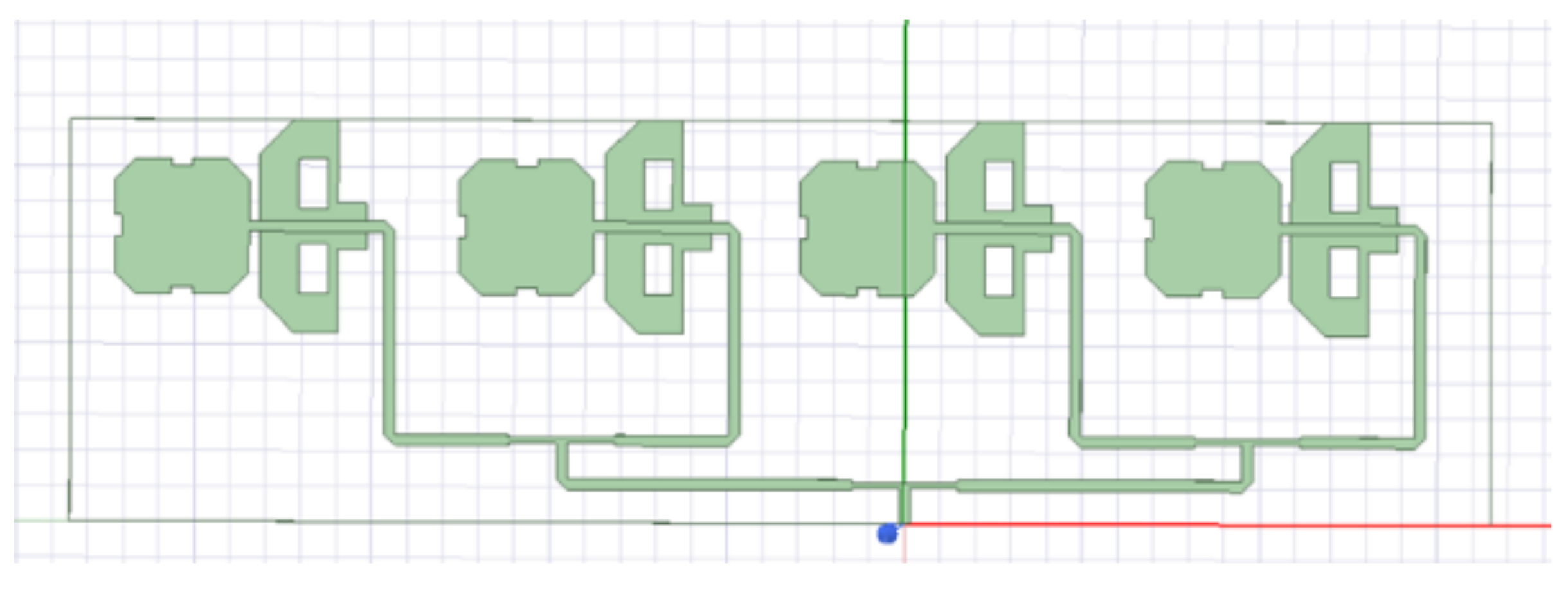
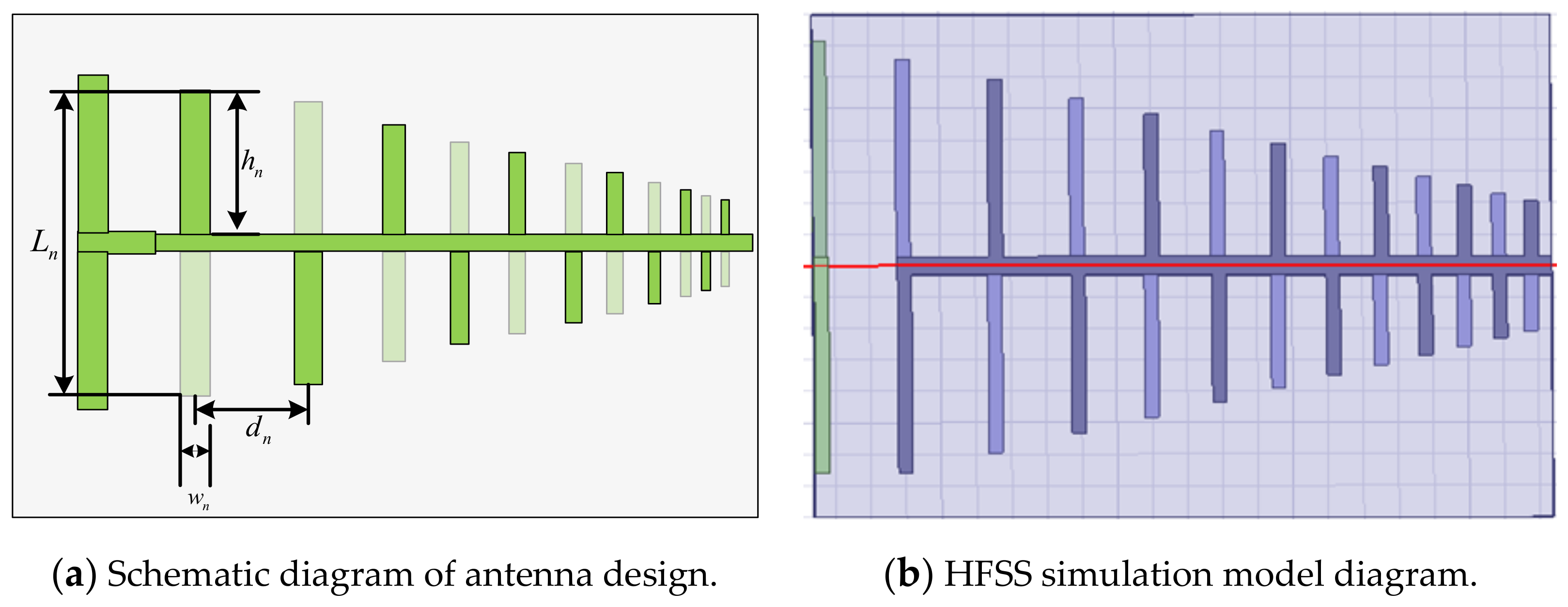
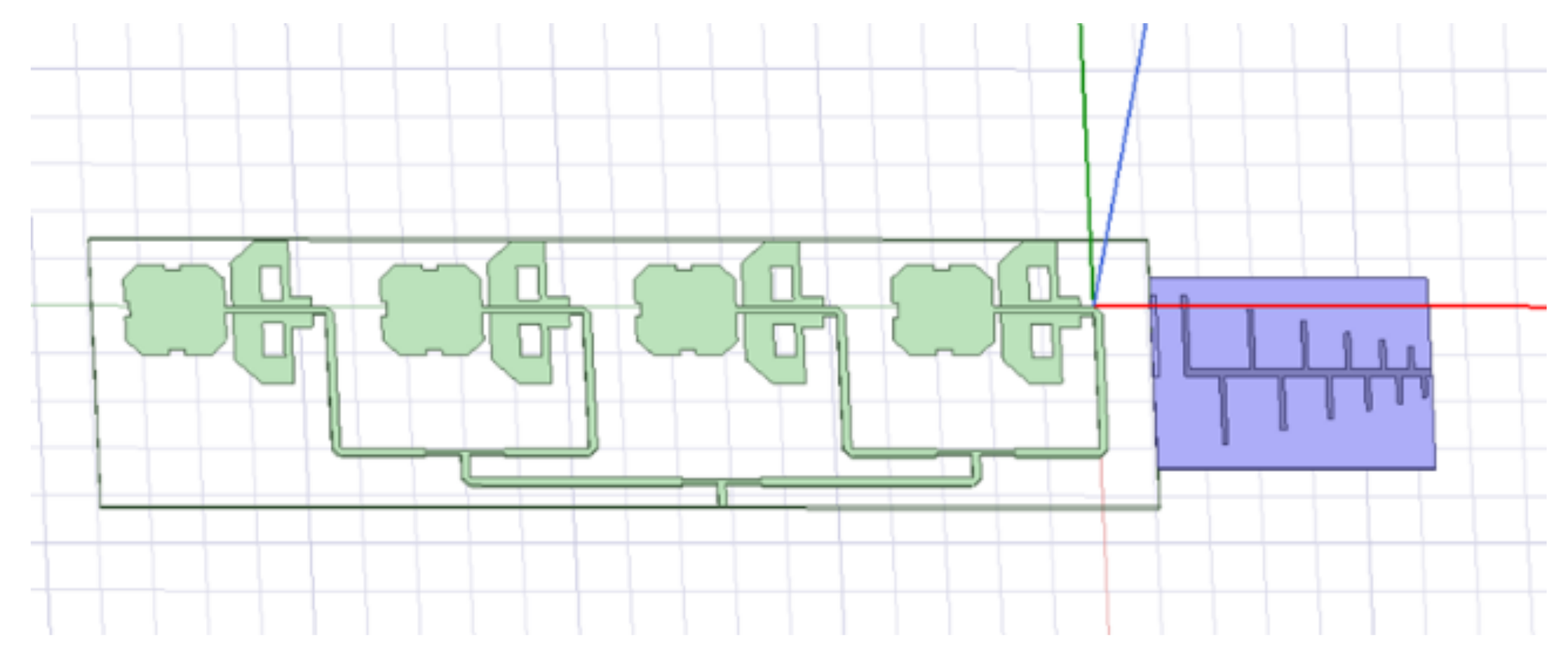


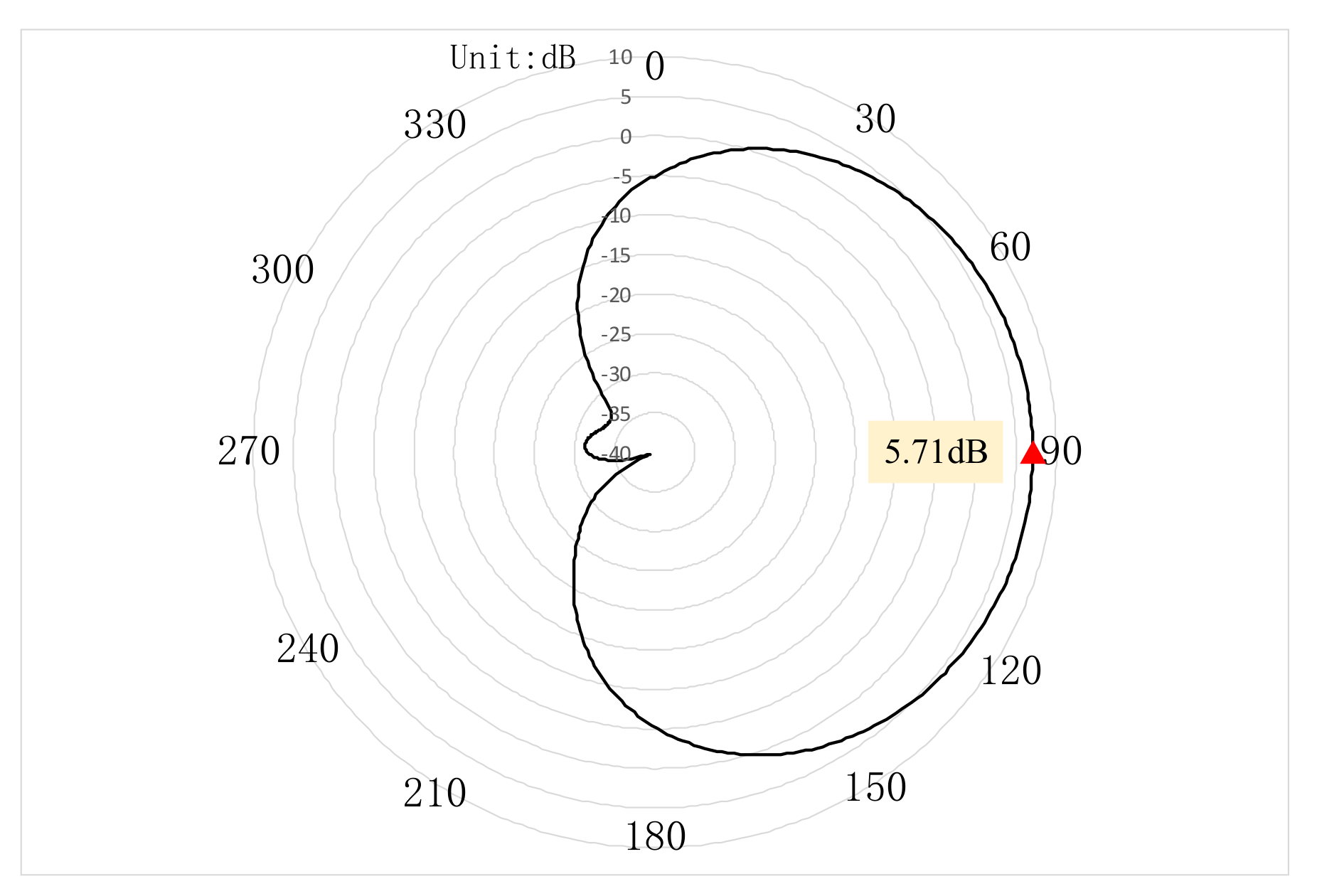


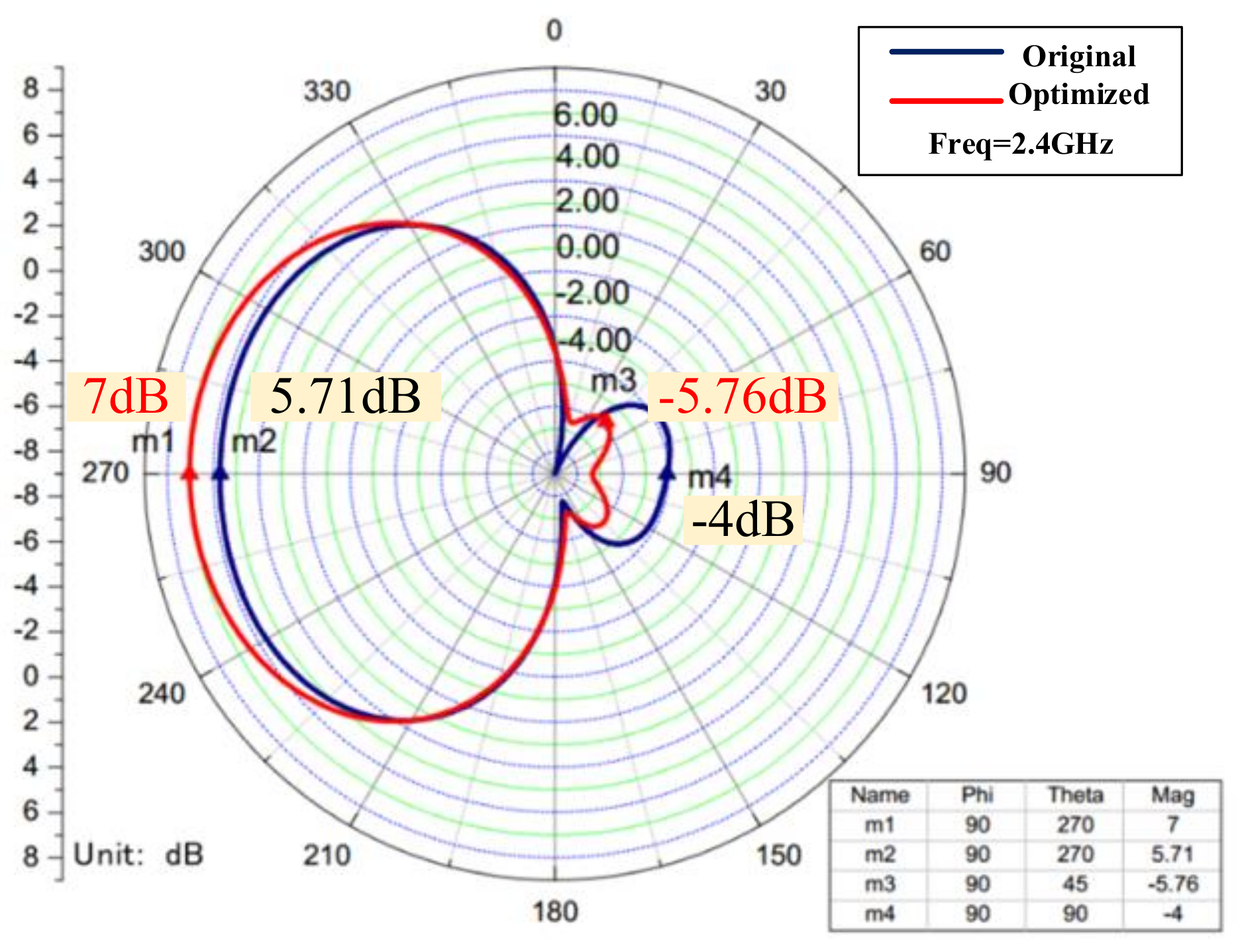
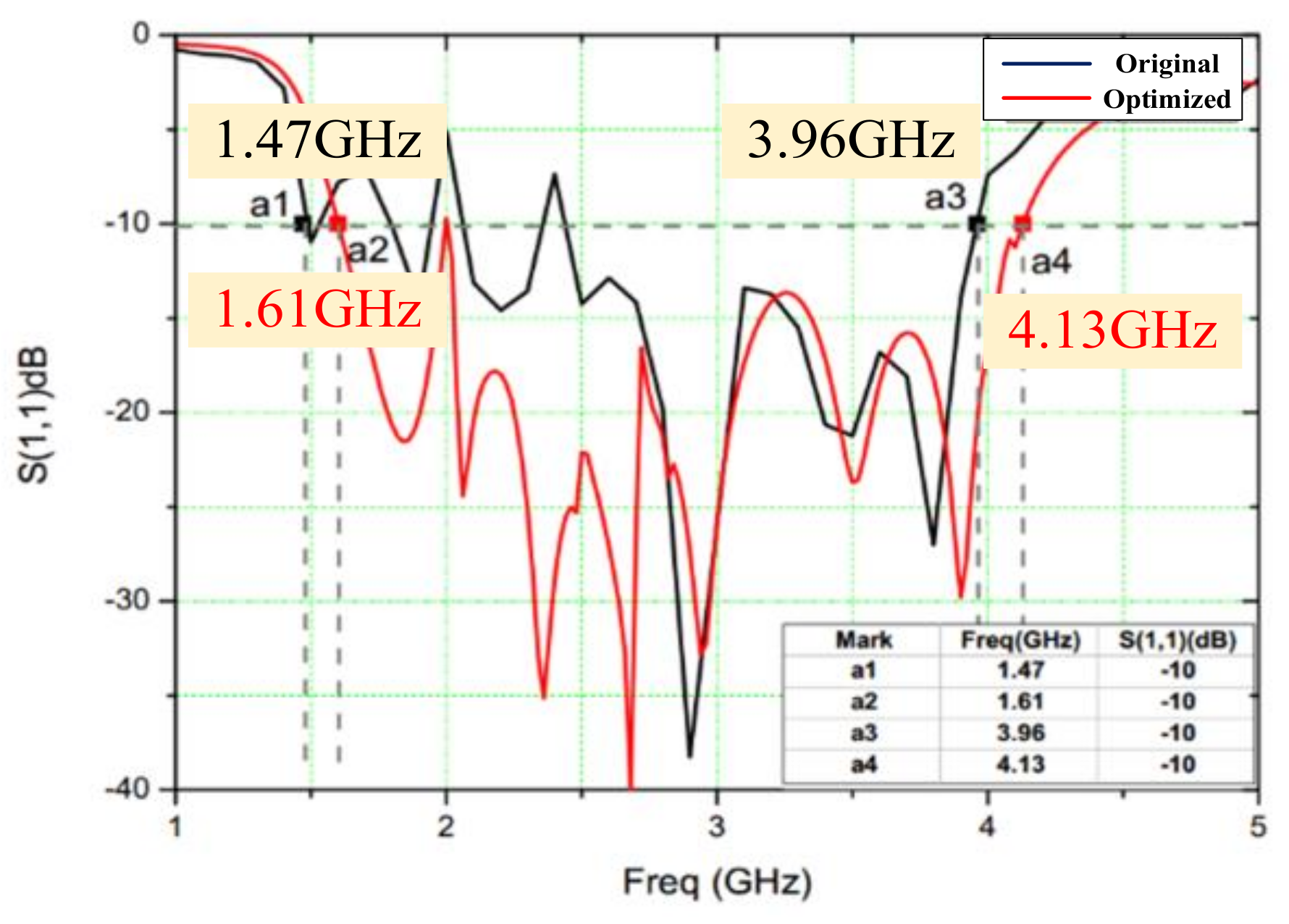
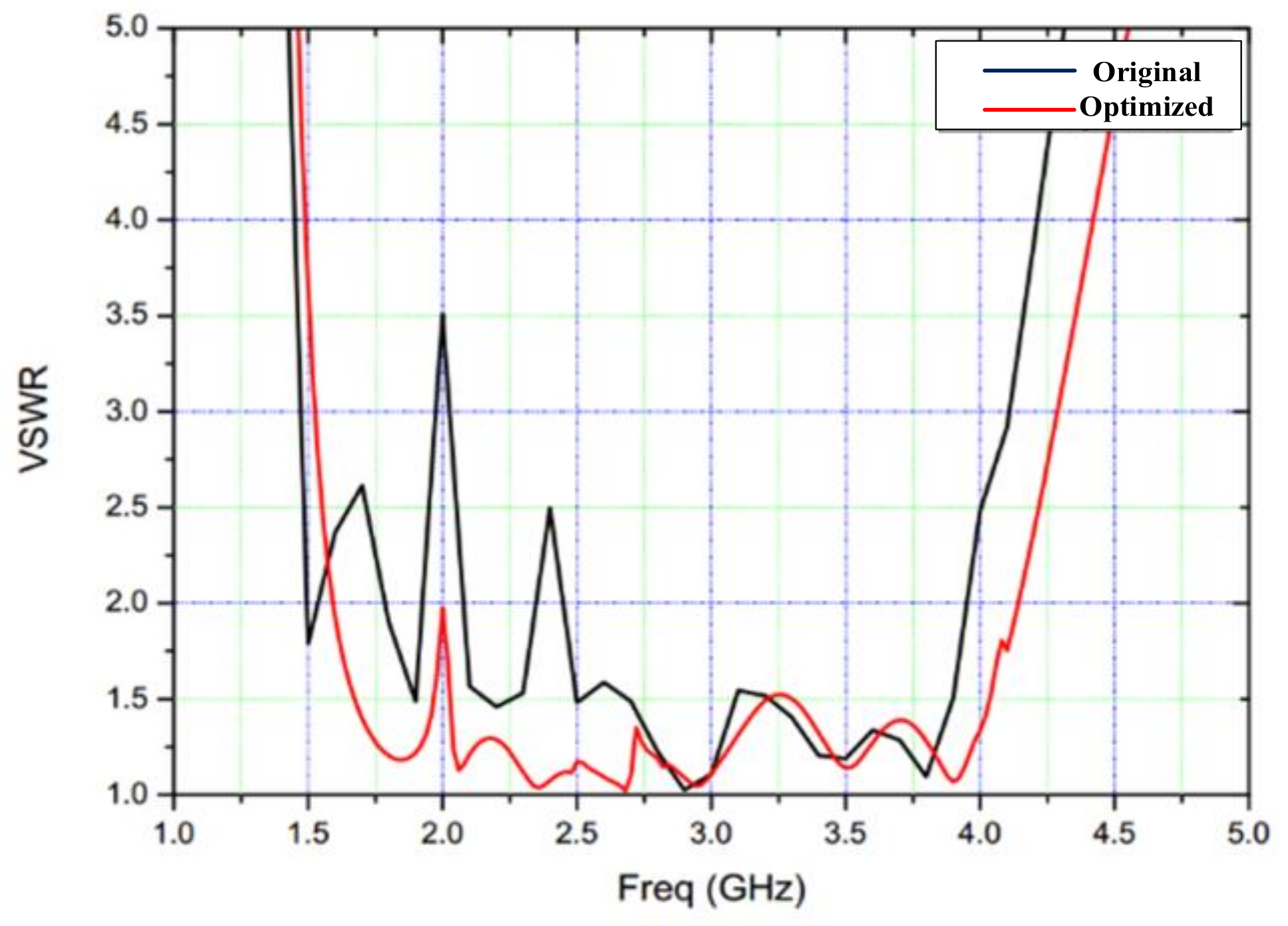

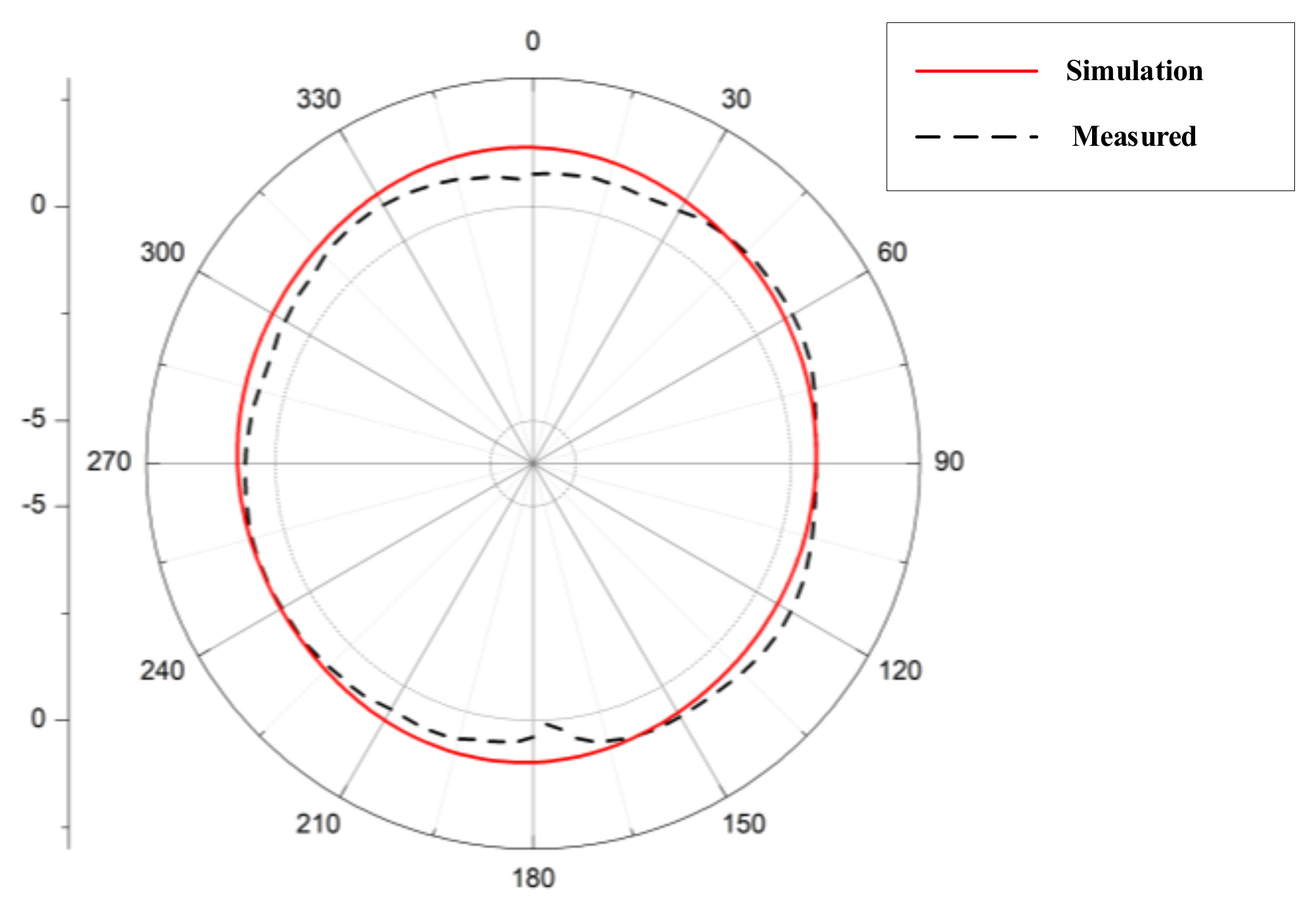
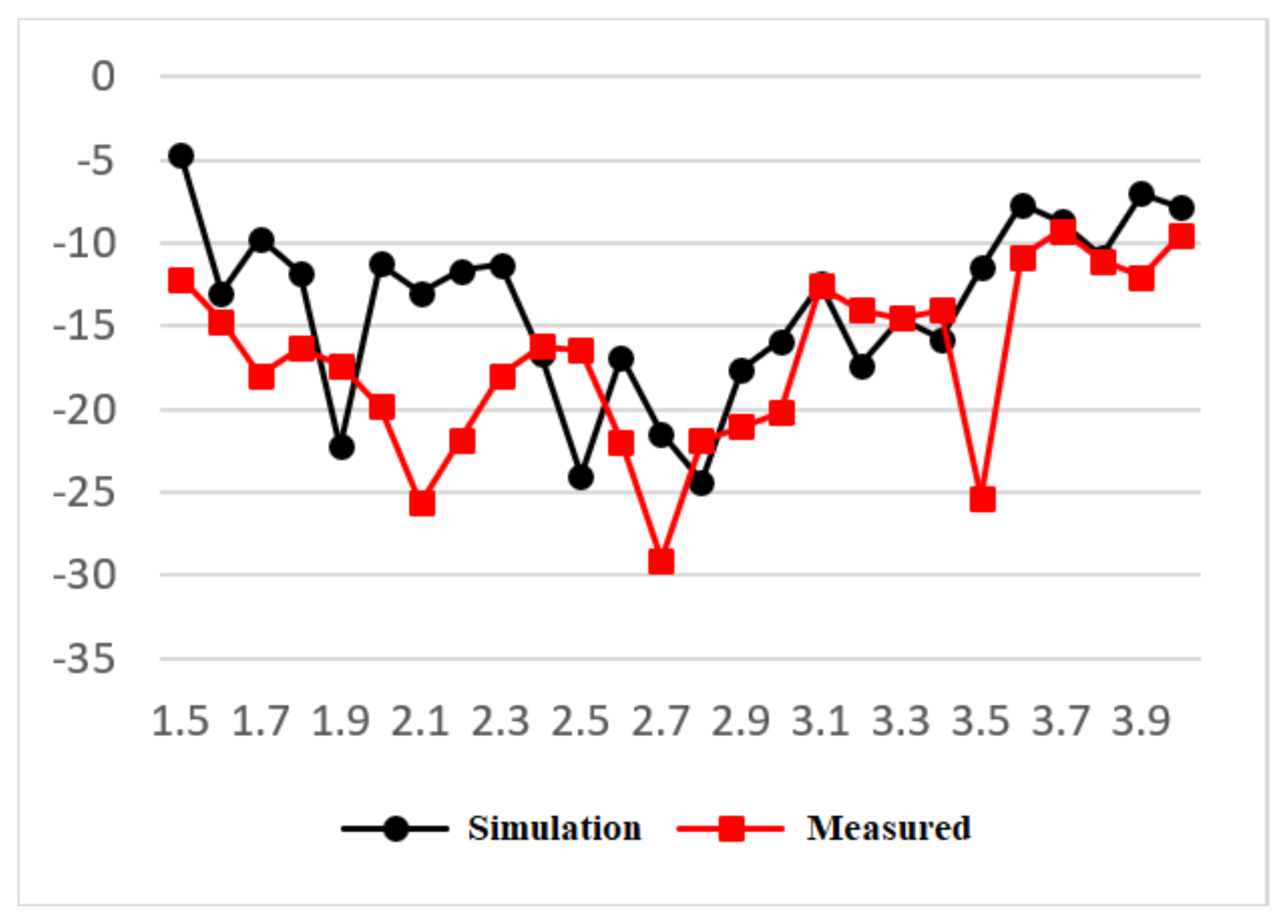
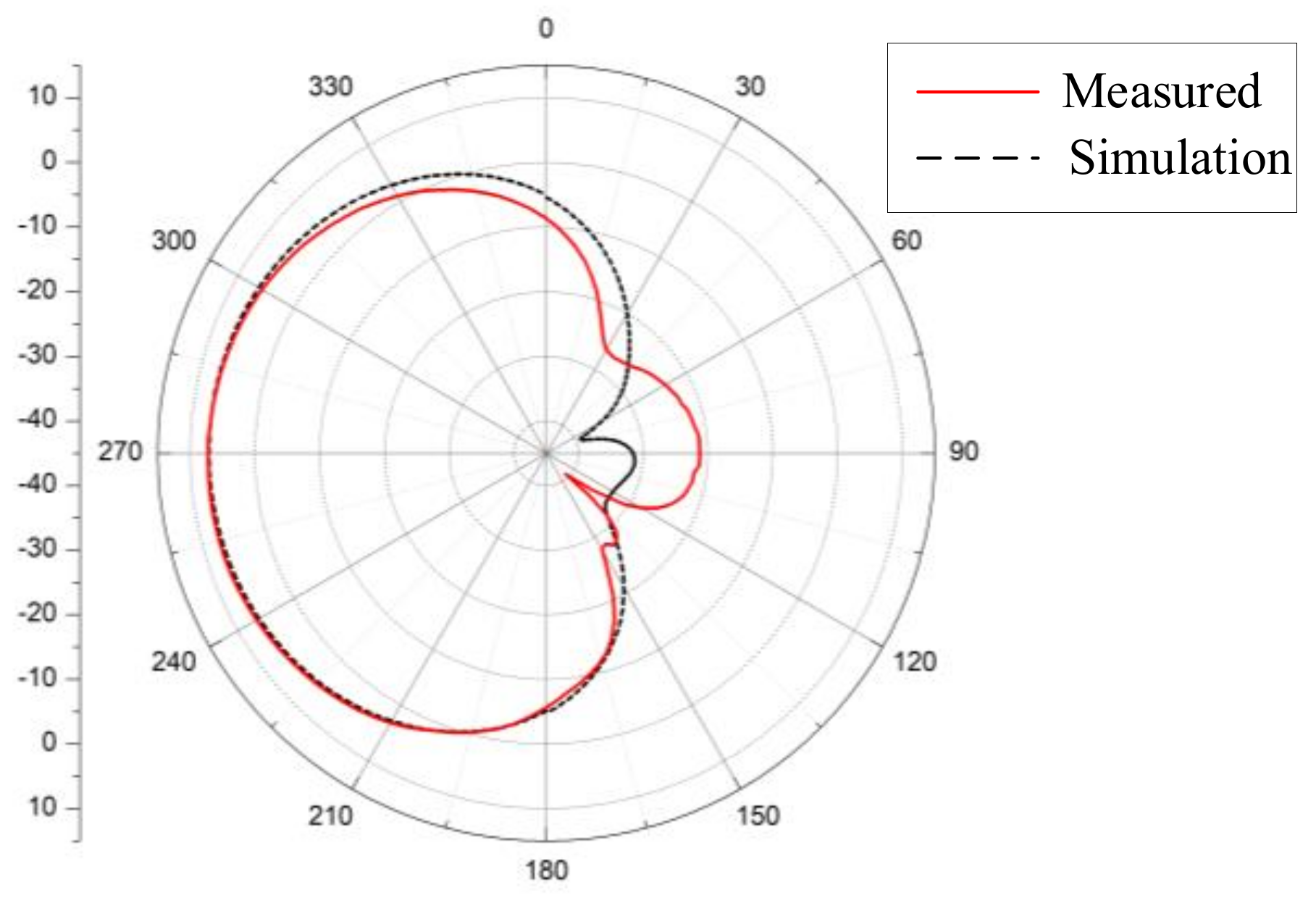
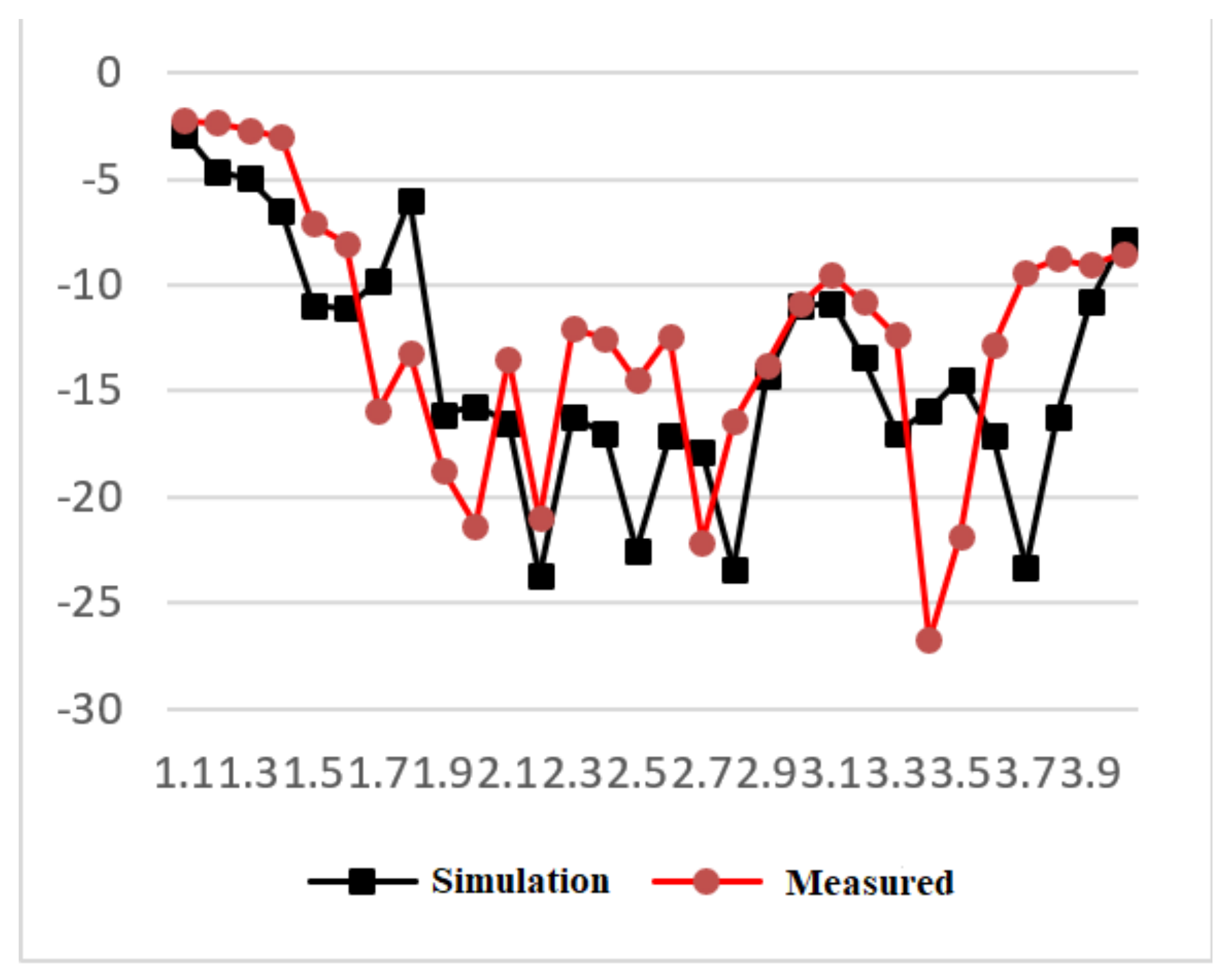




| g | t1 | t2 | w1 | h1 | L | w2 |
|---|---|---|---|---|---|---|
| 38 | 9.6 | 6 | 6 | 2 | 71 | 14 |
| h2 | w3 | h3 | wid | w4 | h4 | |
| 8 | 23.6 | 8 | 3 | 57.2 | 30 |
| L1 | L2 | L3 | L4 | L5 | L6 | L7 |
| 36 | 32.4 | 29 | 26.1 | 23.5 | 21.3 | 19.2 |
| L8 | L9 | L10 | L11 | L12 | d1 | d2 |
| 17.1 | 15.5 | 14 | 12. 5 | 11.2 | 13 | 12 |
| d3 | d4 | d5 | d6 | d7 | d8 | d9 |
| 10.5 | 9.5 | 8.6 | 7.7 | 7.0 | 6.1 | 5.5 |
| d10 | d11 | L | W | |||
| 5.1 | 4.5 | 130 | 2 |
| L1 | L2 | L3 | L4 | L5 | L6 | L7 |
| 36 | 32.4 | 29.16 | 26.24 | 23.62 | 21.26 | 19.2 |
| L8 | L9 | L10 | L11 | L12 | d1 | d2 |
| 17.22 | 15.50 | 13.95 | 12.55 | 11.30 | 13 | 11.7 |
| d3 | d4 | d5 | d6 | d7 | d8 | d9 |
| 10.53 | 9.48 | 8.53 | 7.68 | 6.91 | 6.22 | 5.60 |
| d10 | d11 | L | W | |||
| 5.04 | 4.53 | 130 | 2 |
| Parameter | Value |
|---|---|
| Working frequency | 2 GHz~3.6 GHz |
| Receiving antenna gain | >6.5 dB |
| Transmitting antenna gain | >6.5 dB |
| Maximum VSWR in bandwidth | <2 |
| Average VSWR | <1.3 |
| Maximum side lobe level | <−4 dB |
| Return loss | <−10 dB |
| Antenna size | <50 cm |
Publisher’s Note: MDPI stays neutral with regard to jurisdictional claims in published maps and institutional affiliations. |
© 2021 by the authors. Licensee MDPI, Basel, Switzerland. This article is an open access article distributed under the terms and conditions of the Creative Commons Attribution (CC BY) license (https://creativecommons.org/licenses/by/4.0/).
Share and Cite
Zhao, J.; Chao, X.; Hong, T.; Wang, P.; Zheng, S. Efficient Directional Antenna Design Suitable for Ubiquitous Power Internet of Things. Electronics 2021, 10, 1521. https://doi.org/10.3390/electronics10131521
Zhao J, Chao X, Hong T, Wang P, Zheng S. Efficient Directional Antenna Design Suitable for Ubiquitous Power Internet of Things. Electronics. 2021; 10(13):1521. https://doi.org/10.3390/electronics10131521
Chicago/Turabian StyleZhao, Jingcheng, Xu Chao, Tao Hong, Peng Wang, and Shuli Zheng. 2021. "Efficient Directional Antenna Design Suitable for Ubiquitous Power Internet of Things" Electronics 10, no. 13: 1521. https://doi.org/10.3390/electronics10131521






